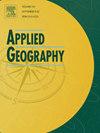绘制农村人类住区特定阶段的相互作用:了解农村客观福祉的途径
IF 5.4
2区 地球科学
Q1 GEOGRAPHY
引用次数: 0
摘要
在许多发展中国家,由于资源有限,同时推进农村人类住区的所有方面是不切实际的。因此,了解住房、基础设施、公共服务和环境系统如何相互作用以影响客观福祉,对于政策制定者设定有效的优先事项至关重要。本研究以中国102个县域为研究对象,构建了基于农村人居环境客观幸福感的人居环境指数(HSWI)。我们将移动窗口法、广义加性模型和社会网络分析相结合,将HSWI排序的整个县网络分解为63个逐步演变的局部集群,捕捉人类住区要素之间特定阶段的非线性相互作用。K-means聚类确定了幸福得分的两个阈值(58和63),将县划分为三个发展阶段:低(<58)、中(58 - 63)和高(>63)。在低水平上,指标紧密相连,住房改善处于网络的中心。在中等水平,围绕村庄环境改善和老年人护理服务形成孤立的积极集群。在高水平上,积极联系增加,新的集群出现,重点是废水处理和废物分类。总的来说,这些发现为发展中国家通过分阶段、重点驱动的战略优化农村福祉提供了可操作的指导。本文章由计算机程序翻译,如有差异,请以英文原文为准。
Mapping the stage-specific interactions in rural human settlements: A pathway to understanding rural objective well-being
In many developing countries, simultaneously advancing all aspects of rural human settlements is impractical due to limited resources. Understanding how housing, infrastructure, public services, and environmental systems interact to influence objective well-being is therefore essential for policymakers to set effective priorities. For this study, we surveyed 102 counties in China to develop a Human Settlements Well-being Index (HSWI), which evaluates objective well-being from the perspective of rural human settlements. We integrated the moving window method, generalized additive models, and social network analysis to break down the overall county network ordered by the HSWI into 63 progressively evolving local clusters, capturing stage-specific nonlinear interactions among human settlement elements. K-means clustering identified two thresholds in well-being scores (58 and 63), dividing counties into three development stages: low (<58), middle (58–63), and high (>63). At the low level, indicators are firmly connected, with housing improvements at the center of the network. At the middle level, isolated positive clusters form around village environmental improvements and elderly care services. The positive connections increase at the high level, and new clusters emerge, focused on wastewater treatment and waste sorting. Collectively, these findings provide actionable guidance for developing countries to optimize rural well-being through phased, priority-driven strategies.
求助全文
通过发布文献求助,成功后即可免费获取论文全文。
去求助
来源期刊

Applied Geography
GEOGRAPHY-
CiteScore
8.00
自引率
2.00%
发文量
134
期刊介绍:
Applied Geography is a journal devoted to the publication of research which utilizes geographic approaches (human, physical, nature-society and GIScience) to resolve human problems that have a spatial dimension. These problems may be related to the assessment, management and allocation of the world physical and/or human resources. The underlying rationale of the journal is that only through a clear understanding of the relevant societal, physical, and coupled natural-humans systems can we resolve such problems. Papers are invited on any theme involving the application of geographical theory and methodology in the resolution of human problems.
 求助内容:
求助内容: 应助结果提醒方式:
应助结果提醒方式:


